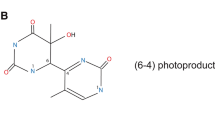Abstract
HERITABLE variants (which we shall refer to as mutants) occur in mammalian cells with high frequency, despite the apparently recessive phenotype of the variant and despite the diploid or heteroploid nature of the cell line. For example, the frequency of 8-azaguanine (8AG)-resistant mutants1 or of hypoxanthine–guanine phosphoribosyl transferase (HGPRT) negative mutants2 does not seem to decrease as an exponential function of the increase in ploidy. Explanations for this high frequency have ranged from the presence of regulatory mutations1, to mechanisms such as non-disjunction or somatic recombination2,3. If the phenotype was due to a dominant mutation, the high frequency of mutants would be expected. We explore this hypothesis here and present two experimental criteria for establishing the presence of dominant mutations which reduce enzyme activity: we restore activity by frameshift mutations or we transfer the mutant phenotype by fusing irradiated mutants with wild-type cells.
Similar content being viewed by others
References
Harris, M. J. cell. Physiol. 78, 177–184 (1971).
Chasin, L. A. J. cell. Physiol. 82, 299–308 (1973).
Sharp, J. D., Capecchi, N. E. & Capecchi, M. R. Proc. natn. Acad. Sci. U.S.A. 70, 3145–3149 (1973).
Wahl, G. M., Hughes, S. H. & Capecchi, M. R. J. cell. Physiol. 85, 307–320 (1975).
Hartman, P. E., Levine, K., Hartman, Z. & Berger, H. Science 172, 1058–1060 (1971).
Clive, D., Flamm, W. G. & Machesko, M. R. Mutat. Res. 14, 262–264 (1972).
Hori, T. & Lark, K. G. J. molec. Biol. 77, 391–404 (1973).
Goss, S. J. & Harris, H. Nature 255, 680–684 (1975); J. Cell Sci. 25, 17–37 (1977); 25, 39–57 (1977).
Hughes, S. H., Wahl, G. M. & Capecchi, M. R. J. biol. Chem. 250, 120–126 (1975).
Chasin, L. A. & Urlaub, G. Som. Cell Genet. 2, 453–467 (1976).
Milman, G., Lee, E., Ghangas, G. S., McLaughlin, J. R. & George, M., Jr Proc. natn. Acad. Sci. U.S.A. 73, 4589–4593 (1976).
Author information
Authors and Affiliations
Rights and permissions
About this article
Cite this article
KADOURI, A., KUNCE, J. & LARK, K. Evidence for dominant mutations reducing HGPRT activity. Nature 274, 256–259 (1978). https://doi.org/10.1038/274256a0
Received:
Accepted:
Published:
Issue Date:
DOI: https://doi.org/10.1038/274256a0
- Springer Nature Limited
This article is cited by
-
Induction of 8-azaguanine resistance and sister chromatid exchange in human lymphocytes exposed to mitomycin C and X rays in vitro
Nature (1981)
-
Genetics of the mammalian phenylalanine hydroxylase system. II. Immunological and two-dimensional gel electrophoretic studies of phenylalanine hydroxylase in cultured normal and mutant rat hepatoma cells
Biochemical Genetics (1979)





